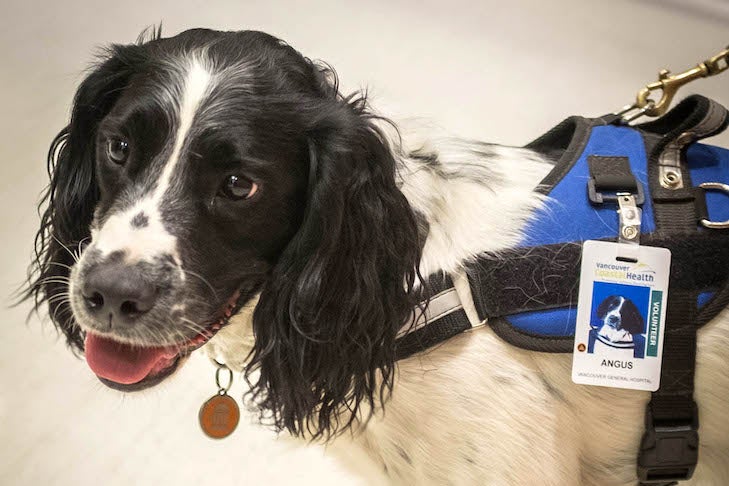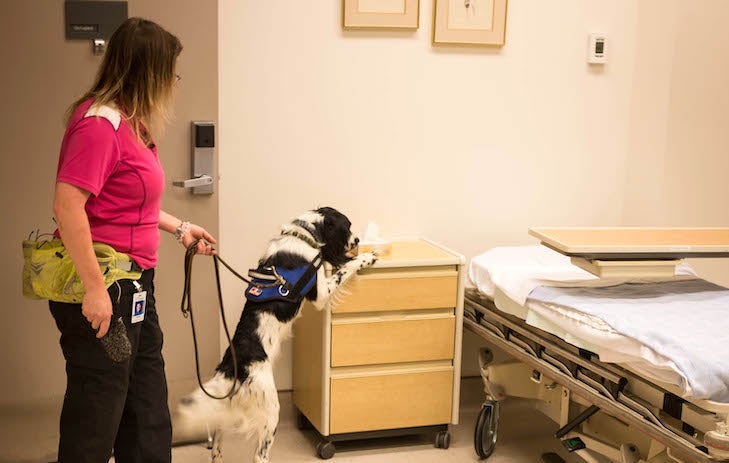
Editor’s Note: The global pandemic has sparked new research exploring whether canine noses can be trained to sniff out the deadly virus. While we’ll have to wait until the University of Pennsylvania study is done for the answer to the COVID-19 question, in the past scientists have successfully trained dogs as infectious-disease detectives. In this classic 2017 column from AKC Family Dog, we caught up with Angus, a young Springer Spaniel at the start of his career sniffing out a killer bacterium in Canadian hospitals.
In the world of sniffer dogs, Angus is in a class by himself. The cheerful, floppy-eared English Springer Spaniel spends his days snuffling through rooms at British Columbia’s Vancouver General Hospital, examining furniture, floors, beds, walls, tables, and even clothing. He’s seeking a whiff of Clostridium difficile (C. diff), a dangerous bacterium that is transmitted through feces.
Three canine noses in the world have so far been trained to detect this bug, but Angus is the first sniffer certified and working regularly, says trainer and handler Teresa Zurberg.
The 3-year-old proudly sports an ID tag with his name and a picture of his smiling black-and-white freckled face and those educated nostrils. He’s become something of a local hero, complete with his own Facebook page.

Bad Bug Rising
In the last 40 years, C. diff, a cousin to the bugs that cause tetanus and gas gangrene, has bloomed into a serious problem. In the U.S. alone, there are about half a million cases annually, costing around $5 billion. A highly toxic, antibiotic-resistant strain has also emerged.
The main C. diff symptom is violent diarrhea. Severe cases can kill.
In 2013 Zurberg learned about this bug the hard way. She got a gash on her leg, which went septic. The treatment—heavy doses of antibiotics—allowed C. diff to go wild. She lost 20 pounds in a week. “It was awful. I almost died,” she says.
When drugs are used to destroy harmful bacteria, there’s collateral damage to beneficial bacteria—the intestinal flora—that help keep pathogens like C. diff in check. That’s why the bug often attacks people who are old and ill, or those on high levels of antibiotics. Healthy people—and strong young dogs like Angus—are not likely to get sick.
About a year after her illness, Zurberg’s husband, Markus, a quality and patient safety coordinator at Vancouver General, came across an article about Cliff, a Beagle in Amsterdam. The dog had been trained to find the bug in people.
Markus asked his wife, “Can you teach a dog to do this?”
“If it’s got an odor, I can train a dog to find it,” she told him.
Zurberg, a former Canadian Forces medic, is a handler certified in K-9 protection, narcotics, and explosives detection. She is also Canada’s first nose work judge.
The couple brought this “wild, crazy, out-of-the-box idea” to the administrators at Vancouver Coastal Health, the health authority overseeing the hospital, who surprisingly gave a go-ahead.

Enter Angus
Zurberg soon started working with 10-week-old Angus, a puppy from a field line. Hunting is in his DNA.
“I love Angus to death, but he’s a pain in the neck to live with. He has no off switch,” she says. He’s also smart, a problem solver, and bomb-proof to most anything going on around him. It all makes him perfect for the job.
“To the dog, it’s just a game,” Zurberg says. “We want him to associate the odors of C. diff to what he really wants, which is his tug toy.”
Cliff the Beagle sought the bug on patients, but Zurberg chose to have her dog focus on the environment. C. diff spreads through spores, which can linger for a long time. The germs can be transmitted by healthcare workers or through contact with contaminated surfaces, such as doorknobs, tables, or TV remote controls.
It’s almost impossible to scan a room for every reservoir of the bacterial spores, but the dog’s keen sense of smell can pick it up quickly and with ease. Angus has been clocked at under 10 seconds in finding hidden C. diff.
Once Angus marks the spot, a housekeeping team, using one of the hospital’s three ultraviolet-C disinfecting robots, goes in for a deep clean.
Elizabeth Bryce, an infection control specialist at Vancouver Coastal Health, recently published the results of the Angus experiment in the Journal of Hospital Infection. The authors, which included both Zurbergs, concluded that a dog can be a valuable aid in stopping the spread of this dangerous germ. Administrators at hospitals around the world have contacted Zurberg about starting a K-9 C. diff program. She’s now writing guidelines to send them.
As for Angus, who has made more than 100 finds since he started working in 2016, he’s getting some company. Another one of Zurberg’s dogs, an English Springer Spaniel named Dodger, has started training as a C. diff sniffer at Vancouver General.
This story ran originally in the November/December 2017 issue of AKC Family Dog
This article is intended solely as general guidance, and does not constitute health or other professional advice. Individual situations and applicable laws vary by jurisdiction, and you are encouraged to obtain appropriate advice from qualified professionals in the applicable jurisdictions. We make no representations or warranties concerning any course of action taken by any person following or otherwise using the information offered or provided in this article, including any such information associated with and provided in connection with third-party products, and we will not be liable for any direct, indirect, consequential, special, exemplary or other damages that may result, including but not limited to economic loss, injury, illness or death.



